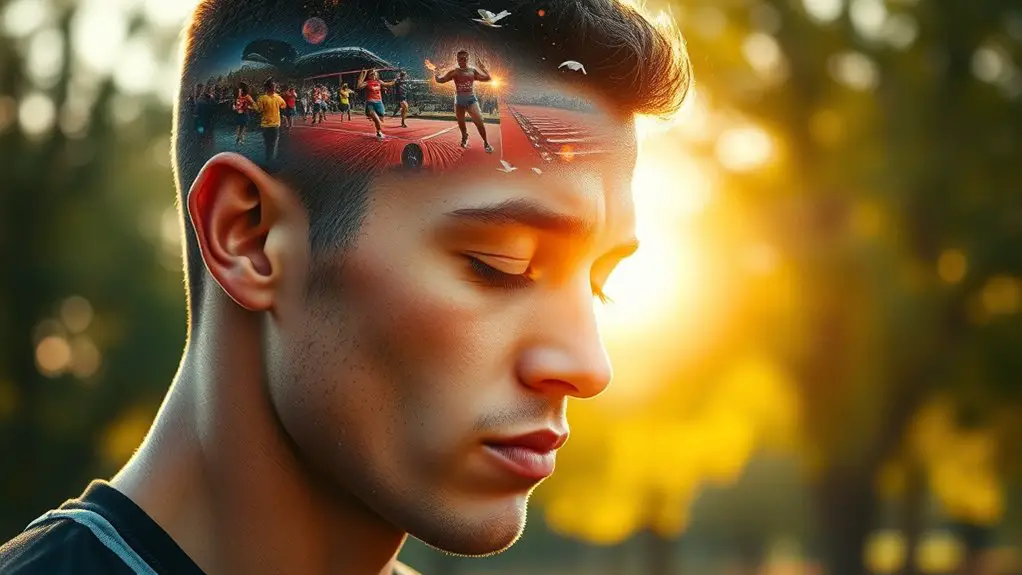To enhance your performance, elite athletes often use powerful visualization techniques. Picture yourself achieving peak performance and feeling the excitement during competition. Engage all your senses to create vivid mental images, like hearing cheers or overcoming obstacles. Daily practice helps reinforce muscle memory and build confidence while transforming anxiety into strength. Incorporate visualization into your training routine for maximum impact. Discover how successful athletes use these techniques to access their true potential and excel in their sport.
Understanding Visualization in Sports
While many athletes rely on physical training to enhance their performance, understanding visualization in sports can be just as essential. Visualization isn't just daydreaming; it's a powerful tool that helps create the athlete mindset you need to excel. By imagining your performance before it happens, you can mentally rehearse each movement, boosting your confidence and focus.
The visualization benefits are vast. You can reduce anxiety, sharpen your concentration, and improve your overall performance. When you visualize success, you're wiring your brain for achievement, making it easier to access that mindset during actual competition. It's about feeling free to explore your potential, pushing boundaries, and embracing the journey. Additionally, the mind-body connection plays a crucial role in maximizing the effectiveness of visualization techniques.
The Science Behind Mental Imagery
Understanding the science behind mental imagery can transform your athletic performance. By harnessing cognitive benefits and tapping into neuroplasticity, you can considerably enhance your skills. Let's explore some effective imagery techniques that can lead you to success. Additionally, incorporating visualization techniques into your training regimen prepares you for high-pressure situations and boosts your confidence.
Cognitive Benefits of Visualization
Although many athletes focus on physical training, the cognitive benefits of visualization can considerably enhance performance. When you visualize, you're not just dreaming; you're sharpening cognitive clarity and building emotional resilience. This mental practice helps you prepare for competition by creating a vivid mental rehearsal, which can improve your focus and decision-making during high-pressure situations.
Here's a quick breakdown of those benefits:
| Cognitive Benefit | Description |
|---|---|
| Cognitive Clarity | Enhances focus and decision-making skills |
| Emotional Resilience | Builds mental toughness in stressful moments |
| Stress Reduction | Lowers anxiety and fosters calmness |
| Confidence Boost | Reinforces a winning mindset |
Harnessing these benefits can free your mind, allowing you to perform at your best when it counts.
Neuroplasticity and Performance Enhancement
When you engage in mental imagery, you're tapping into the brain's remarkable ability to reorganize itself—a phenomenon known as neuroplasticity. This neuroplasticity impact allows your brain to form new neural connections, enhancing skills and improving performance. By vividly imagining your actions, you can trick your brain into believing you've already practiced them, which leads to performance optimization. This means that every time you visualize a successful move or strategy, you're reinforcing those connections, making them stronger and more efficient. It's like giving your mind the freedom to practice without physical limitations. Embrace this power, and watch as your performance soars. By harnessing neuroplasticity through mental imagery, you're revealing your true potential in ways you never thought possible.
Imagery Techniques for Success
Imagery techniques can greatly enhance your performance by leveraging the brain's capacity for visualization. By tapping into different imagery types, like motivational or instructional imagery, you can create powerful success strategies tailored to your goals. Picture yourself executing perfect movements, feeling the rush of victory, or overcoming obstacles with ease. This mental rehearsal not only boosts confidence but also conditions your brain for real-life scenarios. You can use imagery before competitions to anchor positive emotions or during practice to refine skills. When you visualize success vividly, you're not just dreaming; you're programming your mind for achievement. So, embrace these imagery techniques and watch your athletic performance soar as you reveal your full potential.
Guided Visualization Techniques
Guided visualization techniques offer athletes a powerful way to enhance their performance by mentally rehearsing their actions. By using guided imagery, you can create vivid mental scenarios that align with your goals, leading to better focus and confidence. Here are some elements to incorporate into your practice:
- Picture yourself achieving peak performance.
- Feel the energy coursing through your body as you compete.
- Hear the cheers of your supporters, fueling your spirit.
- Visualize overcoming obstacles with grace and determination.
- Embrace the freedom that comes from mastering your craft.
Through performance visualization, you can break free from self-doubt and release your potential. This method allows you to tap into your inner power, transforming your mindset and preparing you for success. Additionally, incorporating mindfulness techniques can further enhance your ability to stay focused and calm during competition. Remember, every great athlete has harnessed the magic of mental imagery—now it's your turn to soar!
Visualization for Skill Acquisition
When you visualize your skills, you're engaging in a powerful form of mental rehearsal that can enhance your performance. By incorporating vivid imagery into your practice sessions, you can help solidify new techniques in your mind. This combination can lead to faster skill acquisition and improved execution on the field or court. Additionally, this practice builds confidence and reduces anxiety through mental imagery, training the mind to see success and preparing the body to respond.
Mental Rehearsal Techniques
Mental rehearsal techniques play an essential role in skill acquisition for elite athletes. By using mental imagery and performance visualization, you can access your potential and enhance your skills. Imagine feeling the thrill of perfecting a move, the rush of adrenaline as you master the challenge ahead. Here's how mental rehearsal can transform your training:
- Visualize success before it happens
- Engage all your senses in the experience
- Create a mental blueprint of your performance
- Boost confidence and reduce anxiety
- Reinforce muscle memory through vivid imagery
Embracing these techniques allows you to break free from limitations, pushing you closer to your goals. Immerse yourself in the visualization process, and watch as your abilities soar to new heights!
Imagery in Practice
Imagery in practice can greatly enhance your skill acquisition as an elite athlete. By engaging in imagery exercises, you can visualize perfecting your techniques and executing skills flawlessly. Picture yourself in various visualization settings, whether it's the pressure of a competition or a relaxed practice environment. This mental rehearsal can help you feel more confident and prepared when it's time to perform.
Try to incorporate specific details in your imagery, like the sounds of the crowd or the feel of the equipment, to make it more vivid. The freedom to explore these scenarios in your mind allows you to refine your skills without physical limitations. Embrace these techniques, and watch as your performance elevates to new heights!
Overcoming Performance Anxiety With Visualization
Although performance anxiety can be crippling for many athletes, visualization techniques can serve as a powerful tool to regain focus and confidence. By practicing performance visualization, you can transform your anxiety into a source of strength. Here are ways visualization can help you break free from anxiety:
- Picture yourself achieving your goals.
- Visualize overcoming obstacles with ease.
- Imagine the thrill of success and the joy it brings.
- Create mental images of calm and control during competition.
- See yourself performing flawlessly, as you've always dreamed.
These techniques are essential for effective anxiety management, allowing you to harness your mind's power. Visualization is particularly effective because it helps to program the mind for positive outcomes, not only boosting your confidence but also liberating you from the chains of fear. Embrace these practices, and watch your performance soar as you connect with the freedom of your true potential.
Creating a Mental Rehearsal Routine
A well-structured rehearsal routine can elevate your performance to new heights. Start by carving out time each day to engage in mental imagery; this helps you visualize your goals and the steps to reach them. Picture every detail of your performance—how it feels, looks, and sounds. Consistency is key, so stick to your routine. Whether it's five minutes or an hour, find a rhythm that suits you and allows your mind to settle into the process.
Consider incorporating specific triggers, like a song or a scent, to make your routine more effective. As you rehearse mentally, let go of any restrictions and embrace the freedom to explore different scenarios. This not only enhances confidence but also prepares you for unexpected challenges. By nurturing a mental rehearsal routine, you'll create a powerful tool that propels you toward success, helping you thrive when it matters most. Additionally, understanding the role of experience can enhance your ability to perform effectively during high-stakes situations.
Integrating Visualization With Physical Training
When you combine visualization with physical training, you release a powerful synergy that can enhance your athletic performance. By weaving visualization exercises into your routine, you can open up a deeper level of freedom and confidence. Here's how you can make this integration impactful:
Combining visualization with physical training unleashes a powerful synergy, enhancing performance and building confidence in athletes.
- Imagine your success: Picture yourself achieving your goals, feeling that rush of accomplishment.
- Enhance your focus: Visualize each movement, honing in on precision and technique.
- Boost your motivation: Create vivid images of your aspirations to fuel your determination.
- Cultivate resilience: Envision overcoming obstacles, strengthening your mental toughness.
- Celebrate small victories: Picture each step forward, no matter how small, as a triumph.
Additionally, incorporating visualization techniques into your routine can significantly improve your mental framework, preparing you for the challenges ahead.
Success Stories: Athletes Who Use Visualization Techniques
Many elite athletes have harnessed the power of visualization techniques to elevate their performance and achieve remarkable success. Take, for instance, Olympic swimmer Michael Phelps, who visualized every swim, down to the feel of the water and the sound of the crowd. This mental rehearsal helped him secure multiple gold medals. Similarly, tennis champion Serena Williams uses mental imagery to visualize winning points, allowing her to focus and perform under pressure.
You, too, can tap into this powerful method. Picture yourself succeeding, whether it's hitting the perfect shot or crossing the finish line. Visualization success isn't just about dreaming; it's about creating a mental blueprint that guides your actions. When elite athletes like Phelps and Williams share their experiences, it shows you the impact of visualization techniques. Embrace this freedom to visualize your goals, and watch how it transforms your performance.
Frequently Asked Questions
How Long Should Athletes Practice Visualization Daily?
When considering how long you should practice visualization daily, aim for about 10 to 20 minutes. It's not just about the duration; practice consistency is key. By committing to regular sessions, you'll enhance your ability to visualize effectively. This can lead to greater freedom in your performance, allowing you to tap into your mental potential. So, find that balance and make visualization a part of your daily routine without feeling pressured.
Can Visualization Techniques Be Used for Team Sports?
Absolutely, you can use visualization techniques in team sports! By visualizing plays and strategies, you enhance team dynamics and foster group cohesion. When you and your teammates mentally rehearse together, it strengthens your connection and understanding on the field. You're not just imagining individual performances; you're building a shared vision. This freedom in creativity can lead to better coordination and trust, ultimately improving your team's overall performance.
What Role Does Breathing Play in Visualization?
Breathing plays an essential role in visualization. By incorporating breathing techniques, you can enhance your mental focus, making it easier to visualize your goals clearly. When you take deep, intentional breaths, you calm your mind and create a sense of freedom, allowing for more vivid imagery. This practice not only helps you concentrate but also reduces anxiety, empowering you to connect with your vision and approach challenges with confidence.
Are There Specific Visualization Techniques for Different Sports?
Each sport's got its own unique demands, and your visualization techniques should reflect that. Imagine soaring through the air in gymnastics or perfectly executing a basketball shot—this is where sport-specific techniques come in. You can use mental rehearsal to see every detail, from your foot placement to your breathing. Tailoring your visualization not only frees your mind but also sharpens your skills, making you feel unstoppable when it counts!
How Can Athletes Measure the Effectiveness of Their Visualization?
You can measure the effectiveness of your visualization by tracking visualization metrics alongside your performance. Set specific goals and monitor your progress over time, noting improvements in your training or competition results. Keep a journal to reflect on your visualization sessions, and assess how they influence your focus and confidence. By aligning performance tracking with your mental practices, you'll find the freedom to enhance your skills and reach new heights in your sport.




